
江戸前鮨 二鶴
Edomaezushinikaku ◆ 二鶴 江戸前鮨 ◆ にかく
3.85
Kokura
「Sushi」
20,000-29,999円
20,000-29,999円
Opening hours: 12:00-14:0017:00-22:00 (L.O. 20:45) Open Sundays
Rest time: Wednesdays and 1st Tuesday Business hours and holidays are subject to change, so please check with the store before visiting.
福岡県北九州市小倉北区足立1-4-31
Photos
(20)






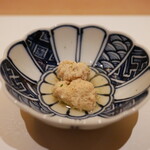

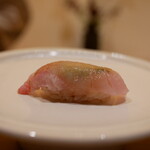











Details
Awards
Reservation Info
Reservations available 24-hour online reservation is available on Pocket Concierge. 24-hour online reservation is available on Pocket Concierge.Pocket Concierge offers 24 小时网上预约。
Payment Method
Credit cards accepted
(VISA, Master, JCB, AMEX, Diners)
Electronic money is not accepted.
Number of Seats
7 seats
(All at counter)
Private Dining Rooms
None
Smoking and Non-Smoking
Smoking is not permitted in the restaurant. However, there is a separate smoking room.
Parking
Yes
1 unit in the back of the store
Facilities
Calm space, counter seating available
Drink
Wine available, focus on sake
Dishes
Focus on fish dishes
Comments
(21)
せとか721
4.20
This time, I visited "Edomae Sushi Nitsuru" in Kokura with my close friends. Nitsuru is one of the few sushi restaurants that uphold the tradition of Edomae sushi. While most sushi restaurants today use sugar in their vinegar rice, Nitsuru only uses vinegar and salt to create a perfectly balanced sushi rice. We enjoyed a variety of dishes, including simmered hamo, sashimi of yellowfin tuna, and nigiri sushi of white sea bream and horse mackerel. The sushi rice was unique and delicious, although it may not suit everyone's taste preference. The interaction with the head chef was like a classroom lesson, as he shared the history of Edomae sushi and insights into the world of seafood. It was a fun and educational experience, and I would love to visit Nitsuru again in the future.




dr_yuma 鮨王
3.80
Pre-war Edo-style traditional conservative aging is almost non-existent. Since it is a traditional sushi restaurant, tastes may vary. I personally don't mind the school as long as it's delicious, so I prefer a free-style sushi restaurant (also serving grilled and fried dishes). I like a lot of Japanese culinary techniques. The presentation may lack a bit of edge, but it is delicious. I felt that the cost performance was a bit poor for the location and content, with prices starting at ¥30,000. However, it is a good restaurant where you can feel the traditional Edo style ⭐️ The hospitality was perfect ✨




よし195016
5.00
Omakase night course 30,000 yen including tax per person ⚫️ Boiled hamo with quail egg ⚫️ Sashimi of spear squid ⚪️ Sweet sea bream cured in kelp ⚪️ Horse mackerel ⚫️ Cold chawanmushi with purple sea urchin from Fue Island ⚪️ Carabineros prawn ⚫️ Summer vegetables with Kamo eggplant ⚪️ Spear squid without wasabi, using Yasunaka negi ⚫️ Sweet sea bream miso-marinated ⚪️ San'in special beef, the sweetest red squid among squids ⚫️ Mana gatsuo roe ⚪️ Otoro (fatty tuna) ⚫️ Summer vegetables with Tsurumurasaki ⚪️ Kohada (gizzard shad) ⚫️ Red squid legs ⚪️ Red sea urchin from Fue Island ⚪️ Kombu-cured red sea bream from the Kanmon Strait ⚪️ Mantis shrimp ⚫️ Miso soup ⚪️ Conger eel ⚪️ Dried gourd roll and tekka maki ⚪️ Tamago (egg) ⚫️ Homemade peach jelly ⚫️ Wagashi from Ukishima, new tea from Hoshino Village


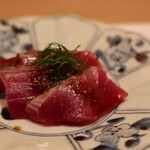

こたーちゃん
4.00
I requested the Pocket Concierge for a ¥30,000 omakase. There were three easy-to-park spaces in front of the store. ⭐︎ Bungo simmered in miso ⭐︎ Grilled Yaito bonito ★ Sweet sea bream with kelp ★ Horse mackerel ⭐︎ Cold chawanmushi with sea urchin, junsai, and Mizenji nori ★ Carabineros shrimp ⭐︎ Kyoto white miso-marinated managatsuo ★ Grilled isaki with kelp ★ Kamo eggplant, myoga ★ Yaito bonito ⭐︎ Isaki milt ★ Red squid ★ Tuna ⭐︎ Turban shell ★ Ariake kohada ★ Kocchi and managatsuo roe ★ Aoshima purple sea urchin ★ Aoshima sea bream ★ Shrimp ★ Conger eel ⭐︎ Red miso soup ★ Tekka maki ★ Hoshigaki roll ★ Tamaki nori roll ★ Tamago ⭐︎ Additional white whelk ★ Additional sea urchin roll ★ Additional sea bream ★ Additional kohada ⭐︎ Citrus water yokan ⭐︎ 10 cups of Urashima sake. It was very satisfying. Thank you for the meal.
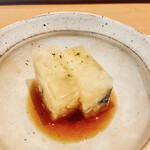



さけ5150
3.00
The dishes were carefully prepared with great attention to detail. The chef's aversion to alcohol resulted in a limited drink selection that may not suit everyone's taste. However, we enjoyed the interesting conversations and had a great time overall.

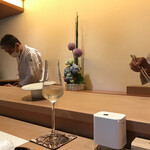


クマシュラン
3.40
From the moment I entered the store, there was a strong smell of vinegar. They were just preparing the sushi rice. The rice had a strong sour taste, and even the pickled ginger was sour. It seems like they focus on ingredients from around Kitakyushu and Yamaguchi. I always eat my sushi within 3 seconds of it being served, and the chef also made the sushi quickly, so it was quite a fast-paced meal for a high-end restaurant. It was delicious, but due to the recent price increases, or maybe because Kitakyushu is generally expensive, I felt like it was about 20% more expensive than I expected.

ぱるたまは食いしん坊
5.00
Visited for the first time on February 18, 2023 (Saturday) from 12:00 pm. Rated 3.87 on Tabelog in 2022, listed in the Top 100 Restaurants in 2019, and awarded 2 Michelin stars in 2022, Go and Miyo 3 Toku Funabashi is run by a chef who trained at the renowned Ginza sushi restaurant "Nifuya Sushi." After returning to his hometown of Kokura in 2002, he opened this restaurant. The menu consists of only omakase courses, with appetizers and nigiri served randomly. The menu included dishes like simmered flounder roe, lightly smoked mantis shrimp, and marinated tilefish. The chef showed a great deal of expertise in Edomae sushi, explaining details about the fish, fishing grounds, ocean currents, and tides with the help of a small computer. The meal was delicious, and the atmosphere was enjoyable.




モグモグの実
4.20
It is December 2022, and I had my last business trip of the year to Fukuoka, followed by an overnight stay in Kokura. For dinner on this day, I made a reservation at the famous sushi restaurant Nitsuru in Kokura. The restaurant is a short taxi ride from Kokura Station, and the name seems to be well-known among the taxi drivers. The recently renovated restaurant has a parking lot and a waiting room, and it looks quite clean inside. When I was seated, some customers had already started their course, so it seems like they don't all start at the same time. Here is a rundown of the dishes for the evening. ◆ indicates appetizers and ◇ indicates sushi. ◆ Mako taro with eggs of a type of cod fish cooked in warm broth, making it a great start to the meal. ◆ Yaitokatsuo, a premium fish with a creamy texture combining the flavors of bonito and mackerel. ◇ White sea bream with a rich and delicious taste, served with lightly vinegared rice. ◇ Marinated horse mackerel with a rich and aged flavor due to the marination process. ◆ Shiitake mushrooms releasing a savory broth when bitten into. ◇ Kibinago lightly cured to enhance the flavor of the fish. ◆ White sea bream marinated in miso, intensifying the richness and umami. ◇ Yaitokatsuo served as sushi, with a delicious taste that might be mistaken for bonito if not specified. ◆ Matsutake mushroom chawanmushi for a palate cleanser. ◇ Boiled sweet shrimp cut into two pieces for a smooth and delightful texture. ◇ Sliced squid with a rich and creamy texture that melts in the mouth. ◆ Daggertooth pike conger dried to a crisp, intensifying the umami flavor. ◇ Tuna from Oma, offering the classic richness and flavor of this fish. ◆ Broccoli with a light and refreshing taste, complemented by a unique sauce. ◇ Striped jack from Hirado with a rich and intense flavor unique to natural striped jack. ◆ Salted squid guts with a refreshing and crunchy texture. ◇ Uni gunkanmaki with a delightful melting texture in the mouth. ◇ Mackerel with a beautiful color and creamy taste due to the seasonal fattiness. ◇ Tilefish with a delicate flavor enhanced by the winter season's richness and umami. ◇ Simmered octopus with a tender texture and a gradual release of umami with each bite. ◇ Conger eel cooked to extreme tenderness, seasoned simply with salt. ◇ Kanpei roll with a rich seasoning and delicious taste. ◇ Tamago sushi with a unique shape and solid deliciousness. ◆ Kiwi water yokan, a high-quality Japanese dessert with a surprising taste at a sushi restaurant. ◆ Ukishima, a unique dessert from Nitsuru with a cocoa bean and red bean mixture baked with eggs, offering a rich texture and exceptional sweetness. Despite not spending over 30,000 yen on beer and sake, the satisfaction level was quite high. The sushi, sourced from the Genkai Sea and other local ingredients from the Kokura region, was delicious. While the technique is Edo-style from the training background, you can feel the love for Kokura throughout. I enjoyed the solid deliciousness and atmosphere, and I will definitely visit again when in Kokura. Thank you for the wonderful meal.




jamkoharu
4.90
I have never given a rating out of 5 points, so I decided to stop there, but I believe that you should not give a score. The meticulous and delicate craftsmanship shown was so impressive. If I had to say something negative, it would be that I wanted to take home the cocoa beans dessert, but it was not possible, so minus one point. I was able to spend a very luxurious and happy time. I wonder if I can go again.




豚たろーお
4.40
I visited Niwazuru recommended by a foodie senior! The charming house has a lovely atmosphere! I ordered the omakase menu and enjoyed the ingredients to the fullest! The extra touch was also wonderful! I like the temperature of the sushi rice and toppings ☺ It was so delicious that I ended up asking for seconds, sorry about that (._.) I also had some drinks like sake! The chef and staff were very friendly, thank you for a wonderful time m(__)m I would love to revisit when I go to Kokura!




ごまら
4.10
We made a reservation for three people and visited the restaurant. I started with Hakkaisan White Beer, which was a rare drink that I enjoyed with sushi. The IWA5 from Shiraiwa Shuzo was a fragrant sake that seemed to be popular in contests like the IWC. It was a new experience for me. We also tried the Sakanahokkaido Gin'yuu, a sake that has been selected for the Nanatsu Hoshi. It was refreshing and easy to drink, and even the women who tasted it were impressed. We also tried the bottled tea from Shizuoka Honshin Chasho, which had a good balance of concentrated tea flavor and freshness. The sushi looked beautiful and was delicious. The sushi rice with red vinegar brought out the flavor of the toppings. We were happy to see kanpyo maki included in the course. The shrimp was rich and sweet, the Hagi red sea urchin had a good flavor and sweetness, and the Ariake kohada was perfectly finished. We even asked for seconds. The Kanmon Strait boiled conger eel had a nice flavor and texture, and the Hama was gentle and tasty, without any bones. The Kakaozuzu (Cacao Beans) chocolate-flavored cookies were not too sweet and delicious. They are made with Tokachi-grown "azuki beans" and "cacao beans," using only a little egg and sugar. They are baked without dairy products or additives, making them a gentle treat for both the body and mind. They are available for reservation sales, making them a nice gift to bring home!




phili204
3.80
Edomae Sushi Nitsuru Sushi WEST 2021, a Michelin-starred restaurant in Fukuoka, offers Edo-style sushi in Kitakyushu. Reservations are required and can be made for one person or more. They serve both lunch and dinner. The restaurant is located about a 15-minute drive from Kokura Station. The interior features an L-shaped counter seat. They offer three different courses. The current third-generation owner, who inherited the thoughts of the previous owner who originally operated in Kitakyushu, learned the basics of Edomae sushi at a long-established sushi restaurant in Tokyo before opening this restaurant in 2002. The sushi rice is made with only red vinegar and salt to bring out the sweetness of the rice and the deliciousness of the fish. You can enjoy a variety of fish from the local waters of Kitakyushu and the surrounding areas, such as Yaito Katsuo and Hagatsuo. Thank you very much. It was a feast. Omakase Nigiri Course ¥18500 includes various dishes such as Makomai no Mako Nigiri, Akami Zuke of natural honmaguro, Hohada of Ariake, salted mackerel of Oita, soy-marinated sawara, kombu-shime of natural madai, Yaito Katsuo of Hagi, smoked Hagatsuo, Aoriika, Toro, pickled mackerel of Nagasaki, ikura, white ama-dai, simmered octopus, anago, red miso, tekka maki, kappamaki, tamago, kabosu water yokan of Oita, Japanese sweets, and drinks such as Junmai Daiginjo: Kan Hokuto, Junmai Namazake: Tenshin.




美味しいものならどこまでも
4.20
Located in a residential area, this lovely sushi restaurant is just a short taxi ride from Ogura Station. It seems to have been recently renovated. They also have a takeout shop next door. The exterior and interior of the restaurant are very charming, with elegant tableware. The skilled chef, dressed in a stylish gray outfit, prepares dishes such as fresh Komai's red snapper sashimi, bonito sashimi, bluefin tuna sushi, gizzard shad sushi, mushroom chawanmushi, shrimp sushi, Spanish mackerel sushi, grilled butterfish, Thai sushi, purple sea urchin sushi, octopus sushi, conger eel sushi, red miso soup, and fig dessert. Even the final cake is homemade and available for takeout. Although the portions are small, each bite-sized dish was delicious. I may have a big appetite, but I truly enjoyed every dish. This charming restaurant is definitely worth a visit. Thank you for the wonderful meal.




カフェモカ男
3.80
I visited "Edomae Sushi Futatsuru" located in Kokura, Kitakyushu City. This restaurant was selected as one of the top 100 sushi restaurants in the West on Tabelog in 2021. In addition, they received two Michelin stars in the 2014 Michelin Guide Fukuoka-Saga, making them the only two-star restaurant in Kitakyushu City. The restaurant is hidden in a residential area, with a distinctive feature of pure white walls and a pure white curtain. Inside, there is a cozy L-shaped counter with seven seats, typical of high-end sushi restaurants. The owner, Setsuo Funabashi, is the third generation and hails from Kitakyushu. He serves Edo-style sushi made with only red vinegar and salt, creating a refreshing taste.
The menu I enjoyed today included:
- Komai (icefish) roe
- White skipjack tuna
- White sea bream
- Sawara (Japanese Spanish mackerel)
- Matsutake mushroom chawanmushi
- Kohada (gizzard shad) from Ariake
- Carabinero prawn from Oita
- Bamboo shoot
- Bonito
- Mackerel miso grilled
- Akai ika (red squid) with shirako (milt)
- Salt-kettle cooked tuna
- Tsunemura purple sea urchin from Yamaguchi
- Nodoguro (blackthroat seaperch) simmered
- Octopus
- Red dashi soup with natural wakame seaweed from Aoshima
- Conger eel kappa maki
- Tekka maki
- Tamago (egg)
- Watermelon fig mizugashi
- Homemade chestnut sweet potato
You can enjoy the freshness of local Kitakyushu seafood and the unique taste of Ariake seaweed. The simple flavor of red vinegar and salt allows you to appreciate the sweetness of the rice and the deliciousness of the fish. I definitely want to visit again. Thank you for the wonderful meal.




tomokovsky tokyo
4.00
I enjoyed the sushi at this restaurant, which was just the right size, carefully prepared, with elegant presentation, in a refined atmosphere. The customers, including an elderly couple, were enjoying their meal peacefully, which was a nice change from the flashy and noisy atmosphere of some places. The humble demeanor of the owner was also memorable. I would love to visit this restaurant again when I'm in Kokura.




oooFe26ooo
2.60
The restaurant that received two stars in the Michelin Guide Fukuoka 2019 edition. I was curious about what sushi in Kitakyushu was like, so I decided to visit for the first time. The sophisticated sushi had a good balance and was perfect for lunch.




ふひと@広島
4.40
I came to Kitakyushu for the new sushi restaurant exploration. The third generation sushi chef, Mr. Funahashi, trained for 12 years at "Futaba Sushi" in Tokyo, returned home at the age of 32 and opened "Edomae Sushi Nituru", which earned two Michelin stars in 2019. Highly recommended by the head chef of "Sushi Master Nomura" in Kagoshima, I was looking forward to visiting. They carefully prepare the bounty of the rich sea of northern Kyushu, finishing it with precise Edo-style techniques to create a smoked silver sushi. The gentle sweetness of the original blend of red vinegar and salt is used to season the shari. The shari is slightly soft and the shari grains are small. The omakase course costs 22,000 yen including tax, plus a drink fee of 4,300 yen, totaling 26,300 yen. I have provided explanations with photos of the dishes. Thank you for the meal.
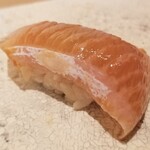



天敵はセロリ
4.50
On my second visit, I tried the natural mozuku from Yamaguchi Prefecture (I forgot the specific location) and it was so delicious with a satisfying crunch that I want to eat it every morning. The sea urchin, known as red uni from Wakamatsu Ward, was surprisingly creamy and delicious, making me think it might actually be ocean milk instead of sea urchin. Even though I usually don't like sea urchin, I could eat this red uni endlessly! The chef kindly explained the origin and knowledge of the ingredients, even using a tablet to explain things like ocean currents. I love sushi, but I love the chef's personality the most. I heard that one of the apprentices runs a shop in Kokura Station for only one group per day, so I would like to visit there next time.




天敵はセロリ
4.50
First time at Ni-tsuru. Nervously called to make a reservation for the night, but the landlady kindly took my reservation. The chef was very kind, explaining each piece's origin as he carefully prepared them. I got so excited that I completely forgot to take pictures while enjoying the sushi. I revisited two weeks later.




タケマシュラン
3.50
"Nikaku" is located in a residential area about a 15-minute taxi ride from Kokura Station. It is a well-known restaurant to the point where taxi drivers in Kokura are familiar with it. It has been awarded 2 Michelin stars and was established in 1965, currently being run by the third generation. The restaurant has a serene atmosphere with only 6-7 counter seats. Chef Senba Fumio honed his skills at the famous Tokyo restaurant "Futaba Sushi" before returning home. The restaurant has a nice middle-aged vibe and is reminiscent of Gion's "Niku no Takumi Miyoshi". The prices for drinks are slightly high, with a small bottle of beer costing around 1,000 yen, and sake around 2,000 yen per serving. On the other hand, champagne is relatively cheaper, starting from 7,000 yen per bottle. The meal started with "Koma-i", made from the eggs of a cod fish, which was warm and enhanced the drinking experience. The Yaito Gatsuo, a rare fish, had a creamy taste that was a blend of tuna, bonito, and mackerel. The Madai was light yet flavorful, and the red vinegar and salt used in the sushi rice had a nice balance. The lean tuna Zuke had a rich aroma and a refined acidity. The pickled ginger was sliced freshly, offering a sharp acidity that complemented the flavors well. The meal continued with steamed egg custard containing Shiromadai and Kuruma Ebi, both rare and high-quality fish. The Shimesaba had a gentle finish with a creamy texture, while the boiled Kuruma Ebi sushi was served warm along with the sushi rice. The Miso-marinated Amadai had a concentrated flavor that paired well with sake. The Sawara had a moist and creamy taste, and the restaurant excelled in preparing fish with a melt-in-your-mouth texture. Hanakkori, a vegetable developed by crossbreeding broccoli, had a softer taste compared to regular broccoli. The Aori Ika had a tender texture and was enjoyable to eat. The oysters from Karatsu were small but packed with flavor. The Otoro had a unique acidity and a delicious fatty richness. The Uni was elegantly presented, with a perfect balance of rice and seaweed. The Kohada was prepared in the traditional Edo-mae style, with a rich aroma and a refreshing aftertaste. The Aori Ika's legs were lightly seared, but it lacked a bit of flavor without additional seasoning. The Buri had a rich fatty texture that melted in the mouth. The Shiromadai made a comeback with a powerful flavor that was surprising. The Anago was delicate and paired well with just a sprinkle of salt, leaving a stylish aftertaste. The red miso soup had a classic flavor. The meal ended with two types of rolled sushi, Kampyo and Tekka, with the latter being a unique presentation with rice sandwiched in seaweed. The experience was almost over, leaving a sense of nostalgia."




akii
4.60
Edomae Sushi Nikaku is a long-established sushi restaurant located at the foot of Mount Adachi, a bit away from the hustle and bustle of Kokura in Kitakyushu City, Fukuoka Prefecture. Founded in 1965, the third-generation owner, Setsuo Funabashi, specializes in authentic Edomae sushi unique to this area. He trained for 12 years at the renowned Nifune Sushi in Tokyo before returning to his hometown in 2002. The seafood used is mainly from the Genkai, Hibiki, and Suo Seas nearby. The restaurant has a modern Japanese atmosphere with a counter made of publican tree wood. It has 8 seats at the L-shaped counter, no private rooms, and is non-smoking. The restaurant has a parking lot at the back. They are open from 12:00 to 14:00 and 17:30 to 22:00, closed on Wednesdays and the first Tuesday of the month. The omakase sushi course starts from 15,000 yen (excluding tax) and the omakase course from 20,000 yen (excluding tax). In the Michelin Guide Fukuoka, Saga, Nagasaki 2019 special edition, the restaurant has retained its two-star rating. During the COVID-19 pandemic, they are busy with takeout orders for their "Fukiyose Chirashi" and "Temaki Sushi". The restaurant offers a hands-free and minimal contact service for customers who pre-order and pre-pay through their website. The reviewer visited the restaurant at the end of the year and found the atmosphere welcoming with safety measures in place such as mask holders, shields, and social distancing. They enjoyed the omakase course with various appetizers, sushi, and desserts, along with a bottle of champagne and sake.




Email Login